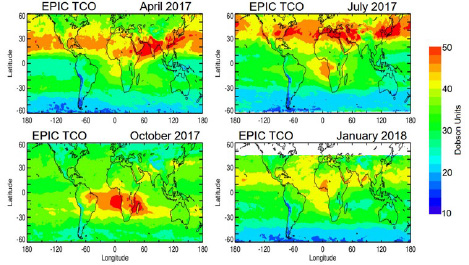EPIC O3
Applying the OMPS (Ozone Mapping and Profiler Suite) derived calibration to EPIC's counts per second to obtain Earth albedos for each of the UV channels, the reflectances can be used to retrieve total column ozone (TCO), Lambert equivalent reflectivity (LER), aerosol optical depth and absorption, aerosol index (AI), and UV reflectance at the Earth's surface. Ozone retrieval requires the use of measured laboratory high spectral resolution absorption coefficients. The EPIC measured reflectance spectra are compared with a set of radiative transfer derived lookup tables for the EPIC filter transmission functions and for a wide range of ozone values. LER, AI, and ozone are retrieved simultaneously with a maximum resolution of 18 km at the sub-satellite point. A matched pair of ozone and LER images are shown in Fig. A1 for August 21, 2016 at 16:58 UT.
EPIC ozone has been compared to ozone retrieved from a Pandora Spectrometer Instrument (PSI) located in Boulder Colorado matched in location and time several times per day. The average agreement is 2.1 ± 5.4% (Fig. A2). An additional comparison (Fig. A3) has been made with the assimilated ozone product from the Modern-Era Retrospective Analysis for Research and Applications, version 2 (MERRA-2) based on Microwave Limb Sounder (MLS) and total column ozone from the Ozone Monitoring Instrument (OMI). All of the structures in the EPIC ozone retrieval are present in the MERRA-2 assimilation model ozone, but with an average offset of about 3%. Comparisons with MERRA-2 have been made using ozone data from other satellites that have similar offsets.
EPIC also provides a tropospheric column ozone (TCO) data product. EPIC TCO is derived by subtracting independently measured stratospheric ozone columns from the EPIC total ozone. The TCO data product files report gridded synoptic maps of TCO measured over the sunlit portion of the Earth disk on a 1-2 hour basis with sampling times and spatial coverage identical to the EPIC L2 total ozone product. The current Version 1.0 of the TCO product is based on Version 3 of the EPIC L1 product and the Version 3 Total Ozone Column Product. Stratospheric column ozone is derived from the Modern-Era Retrospective analysis for Research and Applications Version 2 (MERRA-2) ozone fields. Figure A4 shows an example of the 1-2 hourly maps of EPIC TCO averaged monthly.
The EPIC Ozone products are available at the Atmospheric Science Data Center (ASDC) at NASA Langley Research Center: https://search.earthdata.nasa.gov/search/collections?q=dscovr_epic_l2_to3_01&ok=dscovr_epic_l2_to3_01
See also https://eosweb.larc.nasa.gov/project/dscovr/dscovr_epic_l2_to3_01.

Figure A1. EPIC retrieved ozone and LER values for April 21, 2016 at 16:58 UTC. The ozone scale is from 100 to 500 DU, and the LER scale is from 0 to 100 percent.


Figure A2. Left: EPIC ozone data compare to Pandora retrievals at Boulder Colorado. Right: daily (grey circles) and monthly (solid line) average difference between Pandora and EPIC ozone retrievals.

Figure A3. Comparison of EPIC total column ozone with the MERRA-2 assimilation ozone model for April 17, 2016.

Figure A4. EPIC TCO hourly maps averaged monthly (indicated) in Dobson Units.